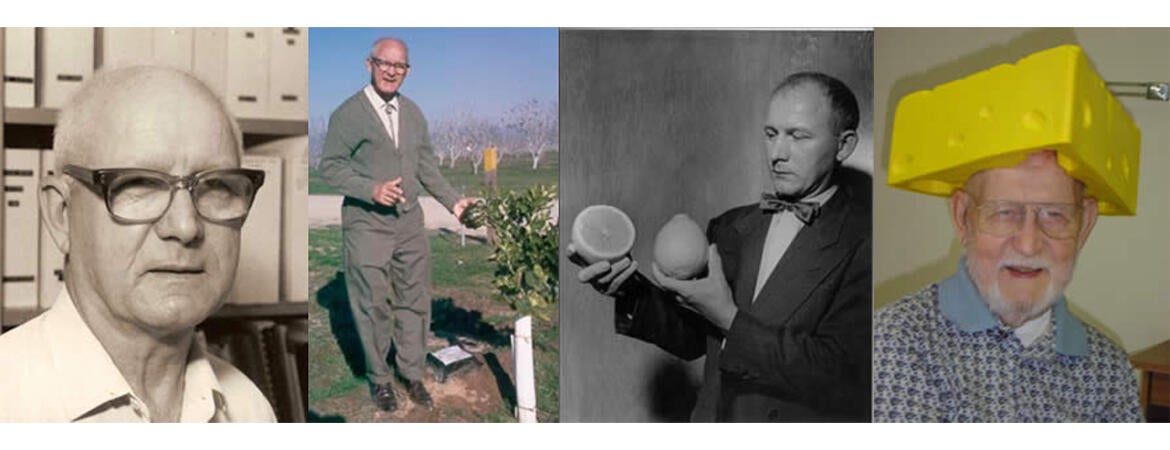
Curator of the Citrus Variety Collection from 1947 to 1982, he researched citrus rootstocks and varieties and traveled the world to help the California Citrus Industry survive threats such as the citrus tristeza virus.
RIVERSIDE, Calif. – Dr. W. P. Bitters, a long-time citrus researcher who served as curator of the Citrus Variety Collection at UC Riverside, died Thursday March 30, 2006 at the age of 90. He arrived in 1946, even before the founding of UC Riverside, as an assistant horticulturalist at the Citrus Experiment Station. Later he worked as a faculty member in UCR’s Department of Botany and Plant Sciences.
His initial assignment was to work on horticultural aspects of tristeza, a serious vector-transmitted virus disease which threatened to destroy California citrus orchards. Tristeza was already in California and spreading in 1946. At that time most citrus trees in California were grafted trees on a rootstock called sour orange that was known to be susceptible to tristeza. Dr. Bill Bitters was responsible for screening of over 500 cultivars to determine which rootstock-scion combinations were resistant to this disease and yet possessed suitable horticultural characteristics. Of the 500 screened, most were susceptible, but several successful ones were selected and released to the industry. Among these were ‘Troyer’ citrange and Citrus macrophylla, which continue to be important rootstocks worldwide. The industry greatly benefited by such releases. Another important contribution was his developmental work with ‘Flying Dragon’ trifoliate rootstock, which is able to dwarf most standard cultivars by 90 percent, making them easier to harvest.
Perhaps Dr Bitters’ most important contribution was his work with the Citrus Variety Collection. Herbert John Webber, the first director of the Citrus Experiment Station, had initiated and overseen the Citrus Variety Collection up until his death in 1944. When Dr. Bitters became the curator of the collection in 1947, it had been somewhat neglected. At that time the collection also contained trees of avocados, figs, sapotes, guavas, and other fruit trees. Dr. Bitters was responsible for refocusing the collection on citrus, or in other words, for “keeping the Citrus Collection for citrus.” He was also instrumental in increasing the number of accessions in the collection from 600 to 1200. This collection is still recognized as one the major collections of citrus genetic resources in the world. During his time working with the Citrus Variety Collection, Dr. Bitters traveled extensively throughout the citrus growing regions of the world. He became known as a world authority on citrus, and was well versed in many other areas of citriculture. He was the first person to report the existence of the exocortis in Japan, a disease that causes decline, stunting and sometimes death of the tree.
In 1967 Dr. Bitters received the Annual Citrograph Award in recognition of his many outstanding contributions resulting in the utilization of rootstock and scion varieties that produce improved tree growth and fruit quality. In addition to his research activities, Dr Bitters taught two important plant sciences courses at UCR, ‘Citrus Fruits and their Relatives’ and ‘Citriculture’. Dr. Bitters provided background on citrus taxonomy and
cultivation that introduced his love of citrus to many students at UCR, some of whom became leading citrus researchers around the world. He also advised many Masters and Ph.D. students, including Dr. Tracy Kahn, the current curator of the Citrus Variety Collection.
“Dr. Bitters was the conscience of the Citrus Variety Collection and cared deeply about preserving varieties of citrus in their true form”, Kahn said. “Yet he also had a dry sense of humor,” Kahn said. “He thought in puns all the time. We called them “Bitterisms” and in fact, I have a favorite: “In order to find your way around a Citrus Variety Collection – you have to follow the scions”.
Another example of his humor that Kahn remembers occurred in one of the laboratory sessions of his “Citrus Fruits and their Relatives” course. He offered each of the students a slice of a fruit that looked like a sweet orange, but was actually a hybrid between trifolitate orange, a species related to citrus, and sweet orange. Those who took a bite would never forget the horribly acrid favor of the trifoliate orange in this hybrid. “It was a memorable experience,” she said.
Born in Eau Claire, Wisconsin, in June of 1915, Dr. Bitters earned his bachelor’s degree in biology from St. Norbert College and his master’s degree and Ph.D. from the University of Wisconsin. After earning his doctorate, he worked as the superintendent of the Valley Research Farm that belonged to the University of Arizona before moving to what was then the Citrus Experiment Station in Riverside in 1946 as a Horticulturist, becoming a Professor in 1961. After his retirement in 1982, he continued to work with other UCR researchers to improve the quality of the variety collection and to advise others working in citriculture.
He was a member of many academic organizations, including the American Society of Horticultural Science, the International Society of Citriculture, the Japanese Society of Horticultural Science, and the California Lemon’s Men’s Club.
Dr Bitters is survived by his two children, Tom and Katie. No services are currently planned, but UC Riverside holds a memorial service each May to honor faculty, staff and students who have died during the previous year and a citrus tree will be planted in his honor at that time. Those who wish to contribute to his legacy may consider making a donation to the Citrus Variety Collection.